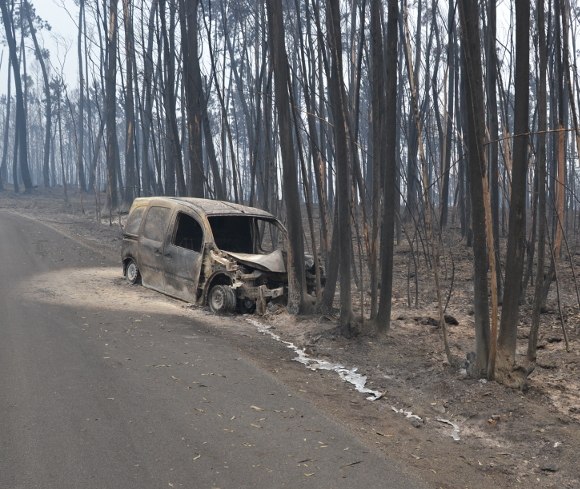Fire and Plantations in Portugal
A case study on the risks of using tree plantations to remove carbon from the atmosphere
by Oliver Munnion
Special Issue, Summer 2018
Devastating wildfires are increasingly a feature of summers across the globe, and their intensity and scale have been linked directly to climate change in a number of recent publications.1 Longer fire seasons, coupled with heatwave and drought conditions, from California to Chile and Siberia to Greece, are more likely, more frequent, and more intense. Forest fires north of the Arctic Circle, unprecedented loss of life in Greece and Portugal, and unique geophysical phenomena such as the “firenados” in California are becoming the “new normal”2 in our climate-changed world.
One response to the climate crisis that is gaining prominence is “Carbon Dioxide Removal” (CDR), and at the forefront of this suite of technological approaches to climate mitigation are afforestation and Bioenergy with Carbon Capture and Storage (BECCS). These geoengineering techniques came to the fore with the IPCC’s 2014 Assessment Report, which assumed major deployments of BECCS in a majority of its “mitigation scenarios” in order to hold global temperatures to below a 2°C increase by 2100.
BECCS: a huge appetite for land and biomass
BECCS and afforestation go hand-in-hand, owing to the enormous feedstock requirements of BECCS. Bioenergy has by far the largest land footprint of any form of energy generation;3 indeed, one estimate suggests that using BECCS to limit the global temperature rise to 2°C would require that crops be planted solely for the purpose of CO2 removal on up to 580 million hectares of land–equivalent to around one-third of the current total arable land globally. Planting at such scale, at least initially, is predicted to involve more release than uptake of greenhouse gases, due to the impacts of land clearance, soil disturbance and use of fertilizers. Rather than helping to conserve biodiversity, this large land footprint could cause a loss of terrestrial species perhaps worse than the losses resulting from a temperature increase of around 2.8°C above pre-industrial levels.4
Moreover, the technical viability of BECCS remains unproven, and for a technology seemingly essential to the IPCC’s global carbon targets there is startlingly little evidence that BECCS can go from being purely conceptual to commercially viable within the timescale required. Many authors have highlighted the dangers of such a reliance on such an unproven, indeed non-existent, technology.5 Optimism about large-scale BECCS deployment is a dangerous distraction6 from much needed efforts to drastically reduce fossil fuel use, and it threatens to legitimize existing forms of dirty bioenergy that are already being scaled up significantly.
Further threat comes from the fact that afforestation requires no technological breakthroughs, so the raw materials for BECCS can and will be planted regardless of the number of BECCS facilities that are actually built. Private-sector involvement in reforestation and afforestation projects prioritizes industrial-scale planting of fast-growing, non-native tree species that can be harvested and sold, whether for bioenergy, pulp, or timber. Such tree plantations bring serious environmental and social impacts.
Portugal is a prime example of the dangers of an approach to climate mitigation that relies on sequestering carbon through tree planting, for BECCS, commercial afforestation or both.
Portugal: the eucalyptus capital of the world
2017 in Portugal will be remembered for extreme heat waves, severe drought, and catastrophic forest fires. Half a million hectares of land burned, equivalent to 5 percent of the national territory the greatest yearly total in the country’s history. Though relatively small in comparison to its southern European neighbors, considerably more of Portugal burned in 2017 than in the rest of Europe combined.7
Portugal leads Europe in another statistic: it has more land planted with eucalyptus than any other EU country. Concentrated in the northern and central regions, roughly 10 percent of Portugal’s land area is planted with Eucalyptus globulus, an exotic, highly invasive, fast-growing subtropical tree.8 In absolute terms, only Brazil, India, Australia, and China have more eucalyptus–relative giants compared to Portugal. But proportionally, Portugal has by far the largest land area planted with eucalyptus in the world.9
The harm caused by fires in Portugal in 2017 was unprecedented. On June 17, 64 people lost their lives near Pedrogão Grande, in the district of Coimbra, central Portugal, in what has been described as Europe’s first “firestorm.” Climatic conditions conspired to create an inferno that eventually covered almost 50,000 hectares in one fire alone. In the days before the fire, temperatures had reached over 40 degrees during a heat wave, with much of the country already experiencing severe to extreme drought conditions. A dry lightning storm ignited multiple fires, and strong winds quickly spread the fires across a huge area.10 The extreme heat wave in Southern Europe in June 2017 has been clearly linked to climate change, with researchers finding that the conditions in Portugal were ten times more likely to have occurred due to global warming.11 Fires raged throughout the summer, culminating in a second firestorm on October 15, in which another 45 people lost their lives. This time, Portugal’s burned area doubled in size overnight, with fires sweeping across huge areas of central and northern Portugal.12
Satellite mapping of the infamous Pedrogão fire has shown that eucalyptus and pine plantations covered around 70% of the burned area, and that these areas experienced high fire severity.13 Both eucalyptus and pine have evolved to deal with fire. They are resinous trees that burn very easily and give off volatile oils that can even spontaneously combust in high temperatures. The bark of eucalyptus trees moves the fire quickly up the trunk and into the highly flammable leaves, both of which can be projected hundreds of meters, spreading the fire quickly.14 Compounding this is the fact that Portugal’s plantations are often illegal and unregulated,15 meaning that adequate firebreaks and zoning are not in place to prevent fires spreading easily.
From a biodiversity perspective, Portugal’s eucalyptus plantations have sometimes been referred to as “green deserts.”16 Eucalyptus leaves give off oils that inhibit soil microorganisms and prevent the growth of other plant species by blocking the development of root systems and inhibiting seed production. Eucalyptus leaves aren’t easily broken down by soil microorganisms (not even goats will eat eucalyptus leaves), and there are fewer invertebrates, fungi, and herbaceous plants in eucalyptus plantations.17
Soils in eucalyptus forests are also highly hydrophobic, which prevents water penetration into the ground and leads to large seasonal fluctuations in water courses, resulting in greater flood risk in winter and drier conditions summer. Similar to soils, the numbers of organisms in water courses in eucalyptus plantations are lower than in water courses in mixed, deciduous forests.18 Eucalyptus plantations also place a significant strain on water resources,19 which for a country like Portugal, experiencing frequent severe drought conditions on top of long, hot, dry summers, has spelled disaster for many rural communities.
Compounding the ecological harm caused by eucalyptus plantations is the way in which they are planted, especially where the land is terraced.20 Heavy machinery is brought in to plow the land on contour, causing significant soil erosion21 as it effectively scrapes away any topsoil and vegetation, leaving bare, exposed subsoil. Eucalyptus saplings will grow in these conditions though, and this planting technique is favored as the resulting plantations require much less maintenance.
Eucalyptus production has been sold to the Portuguese public as a green, environmentally friendly industry, bringing economic benefits to areas with few prospects, and producing a high-value export commodity in the form of paper products. More recently, the wood pellet industry has become another driver, supplying the market for domestic biomass heating. Pellets are even exported to the world’s largest biomass power station, Drax in the UK.22 Still, concerns over the impacts of eucalyptus plantations in Portugal are longstanding–some communities physically uprooted eucalyptus plantations almost three decades ago, citing concerns about fires and the drying up of springs.23 Ultimately, the strength of the pulp and paper lobby and large-scale migration away from rural areas left hillsides abandoned, with landowners turning to eucalyptus as an easy way to turn a small profit from land that would otherwise go unused. 24
Over the years, lack of a coherent forestry policy and the absence of effective management of forest areas has resulted in a planning system that has either not been able to or not wanted to regulate where and how eucalyptus can be planted in Portugal.25 On a national level, subsidies and other public supports have incentivized planting, with few regulatory barriers in the way of doing so. In 2017 alone, Portugal’s government made 18 million Euros available to increase the productivity of plantations, supplementing a 125 million Euro investment by Altri, a leading eucalyptus company.26 A further 9 million Euros came from the EU via a rural development program to support the replanting of eucalyptus where plantations had already been cut three times. These areas are also considered to be at high risk for fire.27
To highlight the extent of illegal planting, the Portuguese forest association Acréscimo has pointed out that some 32 million eucalyptus trees were estimated to have been planted in officially sanctioned plantations in Portugal during 2014 and 2015. But nurseries would have produced 60 million trees over the same period. Acréscimo asks, What happened to those extra trees?28 New laws limiting where eucalyptus can be planted that came into force at the end of 2017 saw a rush to get the trees in the ground ahead of the deadline, meaning that, despite the fires, more eucalyptus was planted than ever before.29
The shocking tragedy of Portugal’s fires has galvanized public opinion against eucalyptus plantations and in favor of replanting native forests. However, the worsening impacts of climate change will undoubtedly mean that without significant positive change to forestry policy and enforcement at the national and local levels, forest fires will continue to worsen. As an example of the lack of political will to restore Portugal’s forests, none of a 27 million Euro budget allocated to planting three ecologically and economically important oak species in 2016 and 2017 was spent,30 despite the clear demand from communities to replace eucalyptus with diverse, native forests. Even in areas burned last year, there is now five times more financial support available for replanting with eucalyptus than for native species.31
The most positive changes since the fires have come from the impacted communities themselves. Villages such as Ferraria de São João and Casal de São Simão, both badly burned in June 2017, have taken matters into their own hands and agreed to remove all fire-prone eucalyptus and pine trees within a 500 metre boundary of houses in the villages, creating “Village Protection Zones,” and replant the area with more fire-resistant, native tree species.32
Throughout Portugal, recognition of the important role played by native trees is growing, in contrast to the clear negative impacts of plantation species. Manuela Raposo Magalhães, a landscape architect and professor at the Lisbon Superior Institute for Agronomy, asks: “Have you noticed that southern Portugal, especially the Alentejo, is much hotter than the north, but rarely burns? Why do you think that this is? The cork oak is abundant in the south and it is a fire retardant species, even when the cork has been removed from the trunk… Similar to deciduous trees, cork oaks have broader leaves, which accumulate more humidity, and hinder the combustion process.”33
Industrial tree plantations are a growing global threat
The Portuguese plantation model has been exported with devastating effects to Brazil, and Mozambique is similarly seeing large investments in eucalyptus plantations destined for the pulp and paper industry; both are former Portuguese colonies. Exotic tree plantations cause significant impacts all over the world, particularly in the global South where companies are allowed to operate with even greater impunity than in Portugal. There, the ecological impacts of tree plantations are compounded by more profound social impacts.
Communities are often violently forced from their homes and denied grazing rights and rights of access to their traditional lands, which increases displacement and reduces food security.34 Indigenous peoples are often involved in land disputes over tree plantations, especially where they do not have legal rights to their land. In Chile, for instance, the indigenous Mapuche have lost access to large areas due to privatization of land and the expansion of monoculture tree plantations. With traditional livelihoods impossible to pursue, very low levels of employment per hectare of plantation mean that prospects can be bleak in plantation areas. The expansion of industrial tree plantations is associated with higher levels of poverty,35 and often bring about land ownership concentration, loss of customary rights of resource access, rural displacement, and socioeconomic decline in neighboring communities. Consequent emigration and decreasing population can in turn lead to isolation and reduced social services and infrastructure for the people that stay.36 A transient, low-paid workforce brings further social problems.37
Despite the clearly documented negative impacts, investment in tree plantations is rising. Indeed, climate finance is increasingly directed towards commercial tree plantations: funds have recently been approved for projects in Brazil, Ghana, Ivory Coast, Mozambique, Paraguay, and Uganda.38 In Mozambique, the Forest Investment Program is funding up to 40,000 hectares of new eucalyptus plantations, to be planted and managed by Portucel, a leading Portuguese pulp and paper company.39 And in Paraguay, the Green Climate Fund recently approved funding for a project that will see eucalyptus and other exotic species planted to produce bioenergy for the soy sector, itself one of the leading causes of deforestation in the country.40
International climate finance depends increasingly on the private sector, which means ever more emphasis on commercial tree plantations as a means of generating revenue. If future climate policy is geared toward reliance on BECCS and afforestation then this trend can only be expected to increase.
Conclusion
It is clear that there is a willingness to finance industrial tree plantations, and that private-sector involvement in climate finance is prioritizing commercial plantations ahead of other approaches to carbon sequestration. The example set by Portugal should serve as a strong warning to policymakers that commercial tree plantations, especially with exotic species such as eucalyptus, do substantially more harm than good. At the extreme end of the scale, tree plantations’ susceptibility to fire is a positive climate feedback, reinforcing hotter, drier climates and leaving soils even more prone to desiccation, erosion and desertification.
There are, however, alternative ways to sequester carbon in natural terrestrial ecosystems that benefit not only the planet but the people who live in and depend on them. In Nepal, for example, one-third of the country’s forests are managed by thousands of forest user groups that include some of the poorest and most vulnerable mountain communities. They have played a central role in halting forest loss and promoting forest restoration, which enhances ecosystem-based climate resilience. In turn, access to forest resources has provided an income for the communities.41
To be effective, such alternative approaches require a substantially different form of governance, with much greater emphasis on rights-holders and avoidance of corporate capture. Rights-based and community-led forest restoration could, in theory, involve many positive schemes that together would help to mitigate climate change on a large scale. There are vast areas of deforested and degraded lands that could be restored through community-led, bottom-up approaches. In many parts of the world such schemes are already being practiced by people in their everyday lives. Ecosystem regeneration, agroecology, and indeed many forms of peasant agriculture do restore and conserve terrestrial ecosystems, sequestering carbon on many different scales. Supporting these kinds of practices should be at the forefront of climate mitigation strategies.
References
- See John T. Abatzoglou and A. Park Williams, “Impact of anthropogenic climate change on wildfire across western US forests”, PNAS 113, no. 4 (2016) http://www.pnas.org/content/pnas/113/42/11770.full.pdf and Anthony LeRoy Westerling, “Increasing western US forest wildfire activity:sensitivity to changes in the timing of spring”, Phil. Trans. R. Soc. B, 371 (2016) http://ulmo.ucmerced.edu/pdffiles/16RSTB_Westerling.pdf and Brian J Harvey, “Human-caused climate change is now a key driver of forest fire activity in the western United States”, PNAS 113, no. 42 (2016) http://www.pnas.org/content/pnas/113/42/11649.full.pdf
- Michael Le Page & Julia Brown, “Living the Climate Change: Welcome to the New Normal”, New Scientist (2017) https://www.newscientist.com/article/mg23431310-200-living-with-climate-change-welcome-to-the-new-normal/
- Robert McDonald et al., “Energy Sprawl or Energy Efficiency: Climate Policy Impacts on Natural Habitat for the United States of America”, PLoS ONE 4, no. 8 (2009). https://doi.org/10.1371/journal.pone.0006802
- Phil Williamson, “Emissions reduction: Scrutinize CO2 removal methods”, Nature 530 (2016): 153–155.
- See Biofuelwatch and Heinrich Böll Foundation, “Last ditch climate option or wishful thinking?” (2016) http://www.biofuelwatch.org.uk/2016/beccs-report-hbf/ and Sabine Fuss et al., “Betting on negative emissions”, Nature climate change 4 (2014). https://www.nature.com/articles/nclimate2392 and Richard Martin, “The Dubious Promise of Bioenergy Plus Carbon Capture” MIT Technology Review (2016). https://www.technologyreview.com/s/544736/the-dubious-promise-of-bioenergy-plus-carbon-capture/
- Sabine Fuss et al., “Betting on negative emissions”, Nature climate change 4 (2014). https://www.nature.com/articles/nclimate2392
- Claudia Silva, “2017 foi o ano em que mais ardeu nos últimos dez anos — quatro vezes mais que o habitual”, Público (2017). https://www.publico.pt/2017/11/10/sociedade/noticia/2017-foi-o-ano-em-que-mais-ardeu-nos-ultimos-dez-anos–quatro-vezes-mais-que-o-habitual-1792180 and “Portugal fires burn 520,000 hectares, nearly 60 percent of EU total”, Reuters, (2017). https://www.reuters.com/article/us-portugal-fire-area/portugal-fires-burn-520000-hectares-nearly-60-percent-of-eu-total-idUSKBN1CN2F4
- Duro. J. S., “Portugal é o país com maior área de eucalipto”, Jornal de Leiria (2017). https://www.jornaldeleiria.pt/noticia/portugal-e-o-pais-com-maior-area-de-eucalipto-6816
- João. C. and Patricia. N, “Deadly fires in Portugal: the eucalyptus business and European austerity stand accused”, Europe Solidaire Sans Frontières (2017). https://www.europe-solidaire.org/spip.php?article41543] and Mario Lopes, “Quercus e Acréscimo contrariam informações dadas pela Associação da Indústria Papeleira”, Tinta Fresca (2017). http://www.tintafresca.net/News/newsdetail.aspx?news=35d3215b-5313-4777-99cf-40c0c34d9510
- Agência Lusa, “Downburst foi o fenómeno raro de vento que ajudou a propagar o incêndio, explica o IPMA ao governo”, Observador (2017). http://observador.pt/2017/06/21/downburst-foi-o-fenomeno-raro-de-vento-que-ajudou-a-propagar-o-incendio-explica-o-ipma-ao-governo/
- Damian Carrington, “Europe’s extreme June heat clearly linked to climate change, research shows”, The Guardian (2017). https://www.theguardian.com/environment/2017/jun/30/europes-extreme-june-heat-clearly-linked-to-climate-change-research-shows
- Cristina Sambado, “15 de outubro de 2017: “O pior dia do ano em termos de incêndios””, RTP Notícias (2017). https://www.rtp.pt/noticias/pais/15-de-outubro-de-2017-o-pior-dia-do-ano-em-termos-de-incendios_n1040214
- Pedro Venâncio, “Area ardidada e danos provados pelos incendios de Pegrgao Grande e Gois, 2017”, Fogos Florestais (2017). http://www.fogosflorestais.pt/2017/07/area-ardida-e-danos-provocados-pelos.html
- Diogo Barreto and Leonor Riso, “Três especialistas explicam porque incêndio foi tão mortífero”, Sábado (2017). http://www.sabado.pt/portugal/detalhe/tres-especialistas-explicam-porque-incendio-de-pedrogao-foi-tao-mortifero
- Paul Ames, “Portugal’s “Killer forest””, Politico (2017). https://www.politico.eu/article/portugal-fire-eucalyptus-killer-forest/ and Niclas Hoegel, “The future of Portugal’s eucalyptus plantations”, International Forestry Students’ Association Blog (2018). https://blogifsa.wordpress.com/2018/05/08/the-future-of-portugals-eucalyptus-plantations/ and Storm Cunningham, “The Restoration Economy”, Berrett-Koehler Publishers, Inc. (2002): p206
- Caleb Cluff, “Notes from a firefront: How a Portuguese holiday turned deadly”, The Sydney Morning Herald (2017). https://www.smh.com.au/world/notes-from-a-firefront-how-a-portuguese-holiday-turned-deadly-20170803-gxot47.html and BBC News, “EU ‘put Portugal wildlife under threat’” (2007). http://news.bbc.co.uk/2/hi/science/nature/6530743.stm
- J. Camargo, “Eucaliptugal, o ecocídio da floresta nacional”, Visão (2017). http://visao.sapo.pt/ambiente/opiniaoverde/joaocamargo/eucaliptugal-o-ecocidio-da-floresta-nacional=f752575
- Abelho. M. and Graca. M. A. S., “Effects of eucalyptus afforestation on leaf litter dynamics and macroinvertebrate community structure of streams in Central Portugal”, Hydrobiologia 324, no. 3 (1995): 195–204.
- Farley. K. A. et al., “Effects of afforestation on water yield: a global synthesis with implications for policy”, Global Change Biology 11 (2005): 1565–1576.
- Quercus, “Uma visão comun sobre o problems das plantações de eucalipto” (2011). http://www.quercus.pt/images/PDF/Floresta/Uma_vis%C3%A3o_comum_sobre_o_problema_das_planta%C3%A7%C3%B5es_de_eucalipto.pdf
- Shakesby. R. A. et al., “Limiting the soil degradational impacts of wildfire in pine and eucalyptus forests in Portugal”, Applied Geography 16, no. 4 (1996).
- “Biomass sourcing in 2017”, Drax Plc., accessed July 1 2018. https://www.drax.com/sustainability/sourcing/
- Ricardo Rodrigues, “Há 28 anos um povo lutou contra os eucaliptos. E a terra nunca mais ardeu”, Noticias Magazine (2017). https://www.noticiasmagazine.pt/2017/ha-2-28-anos-um-povo-lutou-contra-os-eucaliptos-e-a-terra-nunca-mais-ardeu/
- Bárbara Gonçalves and Henrique M. Pereira, “Regime analysis of the Portuguese land use system”, Pathways Project (2015):p15. http://www.pathways-project.eu/sites/default/files/Country%20report%2010%20Portuguese%20land%20use%20regimes.pdf
- Quercus, “Visão comun.”
- A. Costa, “Governo disponibiliza 18 milhões de euros para melhorar produtividade na plantação de eucalipto,” Observador (2017). http://observador.pt/2017/01/16/governo-disponibiliza-18-milhoes-de-euros-para-melhorar-produtividade-na-plantacao-de-eucalipto/
- M. Lopes, “Governo está a financiar renovação do eucaliptal em zonas como a de Pedrógão”, Público (2017). https://www.publico.pt/2017/06/23/politica/noticia/governo-esta-a-financiar-renovacao-do-eucaliptal-em-zonas-como-a-de-pedrogao-1776653
- “Sobre o controlo das plantações ilegais com eucalipto”, Acrésicmo (2016). http://acrescimoapif.blogspot.pt/2016/09/sobre-o-controlo-das-plantacoes-ilegais.html
- Paulo Cunha, “Plantação de eucalipto bateu recorde no último ano”, Observador (2018). https://observador.pt/2018/06/28/plantacao-de-eucalipto-bateu-recorde-no-ultimo-ano/
- “Em 2 anos, foi nulo o apoio do Governo às arborizações com espécies autóctones”, Acréscimo (2018). http://acrescimoapif.blogspot.com/2018/07/em-2-anos-foi-nulo-o-apoio-do-governo.html
- Ricardo Rodrigues, “Eucaliptos têm cinco vezes mais apoio do que floresta nativa”, Diário de Notícias (2018). https://www.dn.pt/edicao-do-dia/29-jul-2018/interior/-eucaliptos-tem-cinco-vezes-mais-apoio-do-que-floresta-nativa-9650078.html
- Agência Lusa, “Aldeia de Penela já está a cortar eucaliptos, reflorestação arranca em Outubro”, Público (2017). https://www.publico.pt/2017/07/28/sociedade/noticia/aldeia-de-penela-ja-esta-a-cortar-eucaliptos-reflorestacao-arranca-em-outubro-1780642 and Jacinto Silva Duro, “Casal de São Simão (Aguda) deixa políticos a falar e segue exemplo de Ferraria de São João arrancando eucaliptos”, Jornal de Leiria (2017). https://www.jornaldeleiria.pt/noticia/casal-de-sao-simao-aguda-deixa-politicos-falar-e-segue-exemp-6721
- “Incêndios: 29 perguntas que já têm (algumas) respostas” Observador (2017). http://observador.pt/especiais/incendios-25-perguntas-que-ja-tem-algumas-respostas/
- J. F. Gerber, “Conflicts over industrial tree plantations in the South: Who, how and why?” Global Environmental Change 21, (2009): 165–176.
- K. Andersson et al., “More Trees, More Poverty? The Socioeconomic Effects of Tree Plantations in Chile, 2001–2011,” Environmental Management 57, no. 1 (2015).
- S. Charnley, “Industrial Plantation Forestry,” Journal of Sustainable Forestry 21, no. 4 (2005): 35-57.
- Gerber, “Conflicts” 165–176.
- Global Forest Coalition, “The risks of large-scale biosequestration in the context of Carbon Dioxide Removal” (2017). https://globalforestcoalition.org/risks-of-large-scale-biosequestration/
- Republic of Mozambique, “Forest Investment Plan in Mozambique”, Forest Investment Program (2016):p141 https://www.climateinvestmentfunds.org/sites/cif_enc/files/meeting-documents/mozambique_fip_investment_plan.pdf
- Green Climate Fund, “Consideration of funding proposals – Addendum XIII Funding proposal package for FP055” (2017). http://www.greenclimate.fund/documents/20182/820027/GCF_B.18_04_Add.10_Rev.01_-_Funding_proposal_package_for_FP055.pdf/111e9560-113f-4753-9b59-e93115039a0a
- Ministry of Forests and Soil Conservation, “Conservation Landscapes of Nepal” (2016). http://d2ouvy59p0dg6k.cloudfront.net/downloads/conservation_landscapes_of_nepal.pdf












